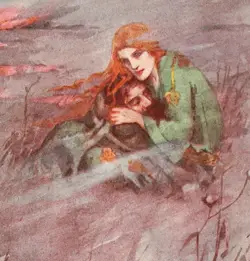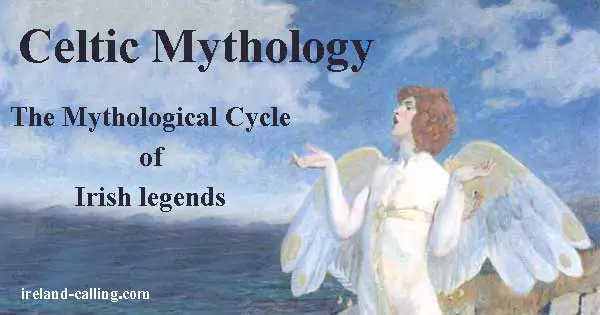The Mythological Cycle tells the stories of ancient Irish gods and godlike people who according to legend arrived in Ireland in a series of invasions dating back over thousands of years.
Much of the cycle relates to the exploits of the Tuatha Dé Danann – the people of the goddess Danu. Some of the best known stories include The Children of Lir, The Wooing of Etain and The Dream of Aengus.
Aengus was the son of the gods, the Dagda and Boann. Boann was the wife of Nechtan at the time so to hide the illicit affair, the Dagda cast a spell making the sun stand still for nine months. This meant Aengus was effectively conceived and born within one day.
When Aengus becomes a man, he returns home one day to find that his father the Dagda has shared all his land between his four legitimate sons leaving nothing for Aengus. Aengus is furious and plays a trick to dispossess the Dagda of his home, the area of Brú na Bóinne, which is now famous for its passage tombs.
Another story, The Dream of Aengus, tells how Aengus pursued a beautiful woman he had seen only in a dream.
The Wooing of Etain
The Wooing Etain features the horse goddess Etain who Aengus had won for his brother Midir. The brothers’ foster mother Fuamnach was jealous of Etain and used a spell to turn her into a butterfly. Aengus manages to turn her back into a woman and makes her his lover. Fuanmach discovers them and drives Etain away. Aengus then turns on his foster mother and kills her in a rage.
The stories in the Mythological Cycle are based on manuscripts drawn up by Irish monks between the 10th and 14th centuries. They began to transcribe the myths and folklore of Ireland which, up to that point, had only been passed by word of mouth through succeeding generations.
It’s thought the Christian monks may have altered the stories so that god-like status of the pagan deities was played down or removed altogether.
The Children of Lir – a nod to Christianity
The Children of Lir is a good example of this. It begins in pagan times when a character called Bobh Derg becomes king of the Tuatha Dé Danann, ahead of his rival Lir. To appease Lir and prevent war, Bobh gives him his daughter Aobh in marriage.

Lir falls in love with her, the marriage is successful and they have four children. When Aobh dies, Lir is heartbroken. King Bobh then offers him his other daughter Aoife to be his second wife. Lir accepts but Aoife becomes jealous of the Lir’s close relationship with his four children.
She tries to kill them but doesn’t have the courage. Instead, she turns them into swans and they have to spend several centuries travelling across Ireland.
The story is steeped in paganism and magic, but the ending illustrates the Christian influence of the monks. It shows the children converting to Christianity as soon as they are returned to human form. It gives them the chance of Christian salvation before they die from age as they are now several hundred years old.
A mythical history of Ireland
One of the other main themes of the Mythological Cycle is its history of Ireland. This is told in relation to the successive groups of people who were said to have invaded Ireland since biblical times. These included the Tuatha Dé Danann, the Fir Bolg and the Milesians.
Their stories are taken from a manuscript dating from the 11th century called Book of Invasions – Lebor Gabála Érenn, in Irish.
The Mythological Cycle is one of four collections of Irish myths. The others are the Ulster Cycle, the Fenian Cycle and the Cycle of Kings.
